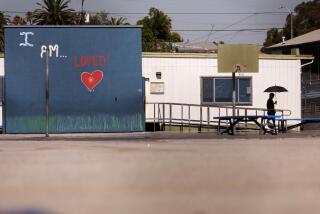Air Conditioning Need May Put Off All-Year Schools
- Share via
Districtwide year-round sessions, a solution to overcrowding favored by a Los Angeles school board majority, may be delayed until 1987 to allow classrooms to be air-conditioned, according to a consensus reached in a special board meeting Thursday.
In addition, a board majority appeared to support increasing the class size by two students--from 27 to 29--in predominantly minority schools.
The board will act on those and other proposals Monday but will not vote on the year-round proposal itself until Dec. 16.
For weeks the board has been examining ways to create more classroom space. District officials said an additional 55,000 classroom seats will be needed within five years.
A board majority made it clear Thursday that the only way they could accept year-round schools would be if the buildings are air-conditioned first. District staff aides said it takes 18 months to two years to install the air-conditioning after bids are opened.
‘Guaranteed or Assured’
“The consensus was clear that we would not put any school on year-round unless we guaranteed or assured parents that the board of education would air-condition their classrooms,” board member Larry Gonzalez, who represents East Los Angeles and who presided over the five-hour meeting, said in an interview.
That sentiment was supported by board member David Armor, the most vocal opponent of year-round sessions. Armor, who represents the San Fernando Valley, said it would be “inhumane” to force students to swelter in classrooms during the summer months.
According to Associate Supt. Jerry Halverson, the district could postpone year-round sessions for at least one year by applying other options. For instance, he said, changing the definition of an integrated school from one that is 60% minority and 40% white to 70% minority and 30% white would provide an additional 10,000 seats, while increasing the class size in predominantly minority schools by two students would open up 21,000 more seats. Both proposals may require court approval, Halverson added.
The year-round option would provide from 107,000 to 154,000 additional spaces, depending on which calendar is used.
The thought of delaying year-round sessions did not please board member Jackie Goldberg, who represents Hollywood and the Central City. Noting that there is a considerable backlog of air-conditioning work in the district’s 93 year-round schools, she said, “We cannot, in good conscience, promise something we cannot deliver.”
Byron Kimball, who oversees district building and maintenance, said it would take about two more years to complete the air-conditioning process in those 93 schools.
Cooling all classrooms in the 525 schools still on the traditional two-semester calendar would cost close to $300 million, district officials have estimated.
Slight Consolation
The prospect of a two-year delay before implementing year-round schools was slight consolation for the proposal’s opponents, who turned out in force at the second of two public hearings on overcrowding held at board headquarters Thursday evening.
David Michels, representing the Nobel Junior High School advisory council in Northridge, criticized the year-round proposal as a “temporary, stop-gap measure” and urged the board to find a way to build new schools instead.
Another parent told the board to consider alternatives for different district areas.
“What is good for one is not necessarily good for all,” said Kay Staub, parent of an 11th-grade student at Birmingham High School in the East San Fernando Valley.
But a board majority also indicated that, if the year-round proposal is approved, it must be equally applied throughout the district, not just in the predominantly minority communities that now have most of the year-round schools.
More to Read
Sign up for Essential California
The most important California stories and recommendations in your inbox every morning.
You may occasionally receive promotional content from the Los Angeles Times.














